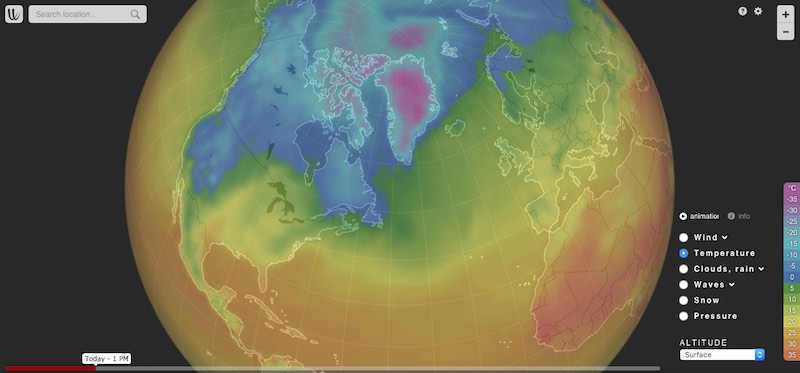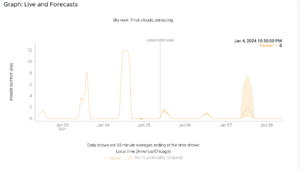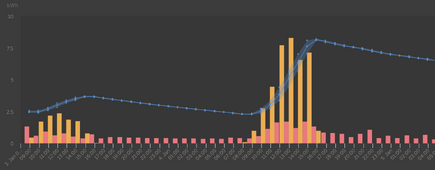B-Mod
Solar Enthusiast

Works ok, can set to see clouds forecasts or satellite views




Not sure there is much ROI on watching the weather, but it sounds fun.
It's not always that simple if you are trying to be off-grid. In my specific case it is to charge another new battery bank up which does not need to happen now and I do not want to deplete my current one any more then necessary when we keep having lots of cloud cover. Knowing if it was in fact going to be sunny tomorrow would mean I could leave the new battery charging.. otherwise I wouldn't.I think all this stuff is neat, but the bottom line is you want to make sure you have enough reserve to make it thru the dry spell, and a big enough storage tank to hold the reserve. So weather is helpful if you lack adequate storage and the production ability to fill it in a timely manner, and are trying to keep reserves for later. I decided to work purely from the SOC of my storage system. When my reserve hits 80% I consider it full, at which point I have no restrictions. If it falls below 40% then I don't allow any elective use. The objective after all is to have enough power when you are not producing. When the weather was crappy for 2 days straight I just shut off the inverters and let the batteries take everything for the next day. I could have let it flip-flop on it's own, didn't see the point but it wouldn't have changed the net results either way.
Not sure there is much ROI on watching the weather, but it sounds fun.
I disagree, I think it can be simple, but your setup can be as complicated as you make it for whatever the reason. "If I could be sure they are bringing me 10 gallons of fuel tomorrow, then I'll put the 10 gallons of fuel I got today in the truck instead of the car, otherwise the car is going to run out of fuel." I get it, I just don't get it anymore. I'll fill the car to 3/4 and then fill the truck to 3/4, then top them off as the fuel is delivered. In the case of my solar it's all one system. Putting energy in battery A or battery B is irrelevant to me since they are all available, at which point it's about reserve. I don't have enough reserve to willy-nilly charge my EV, so I don't unless my PV batteries are charged to a desired threshold first.It's not always that simple if you are trying to be off-grid. In my specific case it is to charge another new battery bank up which does not need to happen now and I do not want to deplete my current one any more then necessary when we keep having lots of cloud cover. Knowing if it was in fact going to be sunny tomorrow would mean I could leave the new battery charging.. otherwise I wouldn't.
I'm sure there are plenty of people that would take different actions if they have some confidence it will be sunny tomorrow for instance and don't have grid for backup or want to waste generator fuel.
I think that's the point. If you are near your extremes you either need to pile a lot of money into more battery banks so that you can cover the extremes or simply have better load management/human behavior.Of course it's only money.
Return on invested time and attention, I think.Return on irradiance?
Return on insolation?

I am in Wisconsin and off-grid and my only other heating source besides solar electric is a wood stove. So, my return on investment for watching the weather and using my batteries to heat with is less firewood to cut, stack, store, split, haul inside, and fuss with every few hours (and have my sleep disturbed when I need to wake up and feed the fire). Also less wear and tear on my tractor, chainsaw, and body...I think all this stuff is neat, but the bottom line is you want to make sure you have enough reserve to make it thru the dry spell, and a big enough storage tank to hold the reserve. So weather is helpful if you lack adequate storage and the production ability to fill it in a timely manner, and are trying to keep reserves for later. I decided to work purely from the SOC of my storage system. When my reserve hits 80% I consider it full, at which point I have no restrictions. If it falls below 40% then I don't allow any elective use. The objective after all is to have enough power when you are not producing. When the weather was crappy for 2 days straight I just shut off the inverters and let the batteries take everything for the next day. I could have let it flip-flop on it's own, didn't see the point but it wouldn't have changed the net results either way.
Not sure there is much ROI on watching the weather, but it sounds fun.
I am in Wisconsin and off-grid and my only other heating source besides solar electric is a wood stove. So, my return on investment for watching the weather and using my batteries to heat with is less firewood to cut, stack, store, split, haul inside, and fuss with every few hours (and have my sleep disturbed when I need to wake up and feed the fire). Also less wear and tear on my tractor, chainsaw, and body...
The less time and more accurately I can forecast solar production, the higher my ROI....
Every situation is different...


